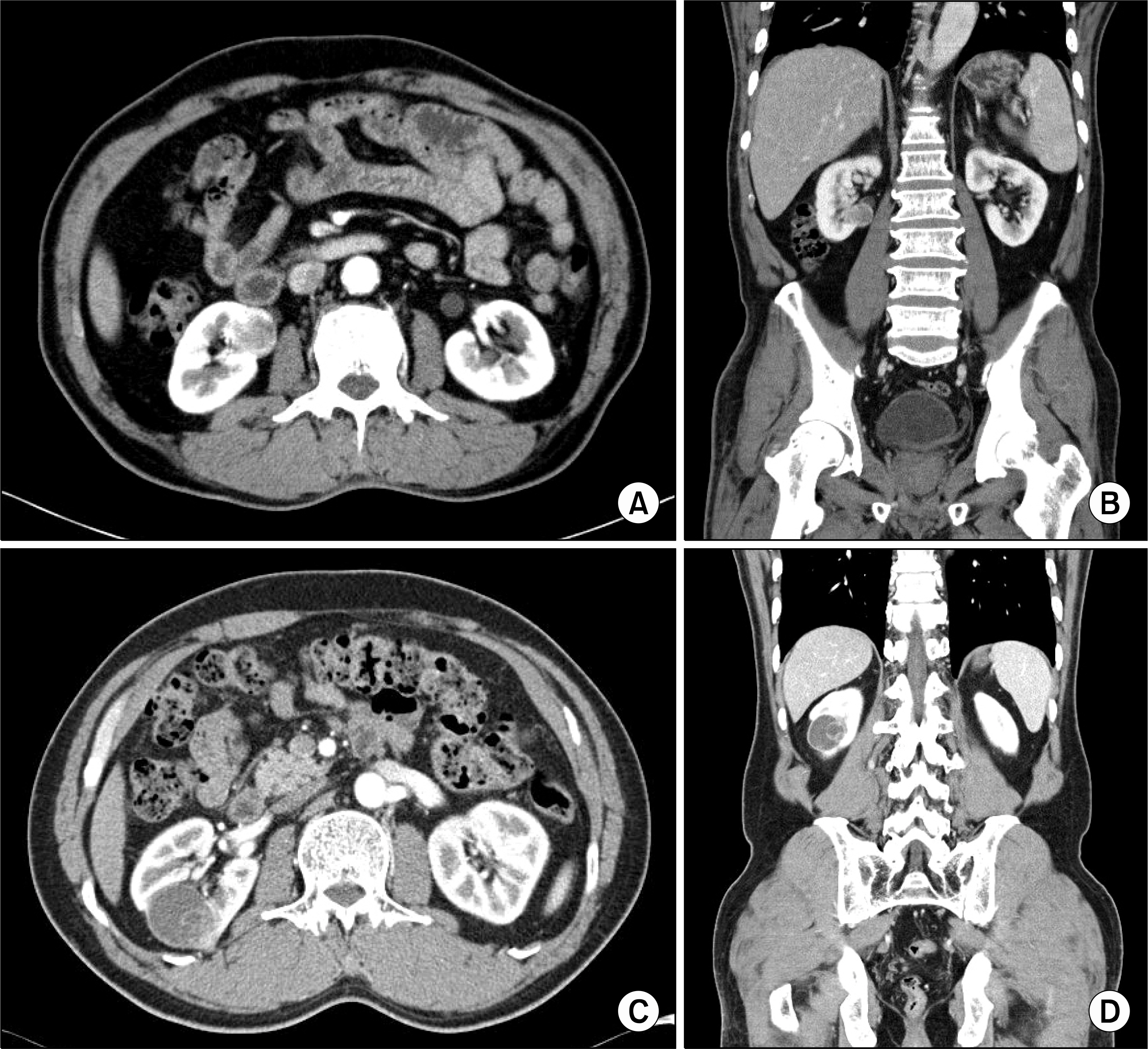Korean J Urol.
2008 Dec;49(12):1067-1073.
Laparoscopic Partial Nephrectomy: An Useful Method of Decision Making for Determining the Approach and Surgical Method Based on the Systematic Classification of Tumor Location
- Affiliations
-
- 1Department of Urology, Eulji University School of Medicine, Daejeon, Korea.
- 2Department of Urology, Boramae Hospital, Seoul National University College of Medicine, Seoul, Korea. sblee@brm.co.kr
Abstract
-
PURPOSE: Laparoscopic patial nephrectomy is still one of challenging surgeries in laparoscopic urologic field and needs skillful technique of surgeons. When performing laparoscopic partial nephrectomy, initial plan of how to approach affects the whole course of the surgery. To propose a systematic decision guideline, we used the tumor location as the determining factor for selecting initial plan and analyzed our initial experience.
MATERIALS AND METHODS
From September 2005 to April 2008, we performed 22 LPNs for small renal tumors less than 40mm in diameter, as measured from the preoperative computed tomography scans. We divided the tumor locations into 18 categories with the combinations of the anterior and posterior renal axes, and the upper, middle, lower parts of the kidney and the peripheral, central and hilar locations of the tumor. According to the tumor location categories, we performed LPNs through the retroperitoneal simple and complex approaches, and the transperitoneal simple and complex approaches.
RESULTS
Twenty of twenty-two tumors(91%) were removed successfully through 4 different approaches, but 2 cases were converted to laparoscopic radical nephrectomies(LRNs). The mean operation time was 203 minutes, including a mean warm ischemic time(WIT) of 30.7 minutes. Among the 17 cases of RCC, 15 tumors were successfully removed via LPNs, and there were no cases with positive margins and no tumor recurrence during a mean of 14.9 months follow-up with a maximum follow-up period of 34 months.
CONCLUSIONS
Dividing the tumor location into 18 categories is useful for deciding on the appropriate laparoscopic approach.
Keyword
MeSH Terms
Figure
Reference
-
References
1. Ljungberg B, Hanbury DC, Kuczyk MA, Merseburger AS, Mulders PF, Patard JJ, et al. Renal cell carcinoma guideline. Eur Urol. 2007; 51:1502–10.
Article2. Cockcroft DW, Gault MH. Prediction of creatinine clearance from serum creatinine. Nephron. 1976; 16:31–41.
Article3. Winfield HN, Donovan JF, Godet AS, Clayman RV. Laparo-scopic partial nephrectomy: initial case report for benign disease. J Endourol. 1993; 7:521–6.
Article4. Porpiglia F, Volpe A, Billia M, Scarpa RM. Laparoscopic versus open partial nephrectomy: analysis of the current literature. Eur Urol. 2008; 53:732–42.
Article5. Hong SH, Ryu KY, Yoo JS, Seo SI, Kim JC, Hwang TK. Laparoscopic partial nephrectomy for the 4cm or less renal tumors. Korean J Urol. 2006; 47:1256–62.
Article6. Seo IY, Bae BJ, Rim JS. Early experience of laparoscopic partial nephrectomy for renal tumor. Korean J Urol. 2007; 47:1–5.
Article7. Bang JK, Song C, Hong B, Park H, Kim CS, Ahn H. The effectiveness of simultaneous renal artery-vein clamping during laparoscopic partial nephrectomy on the surgical outcome. Korean J Urol. 2007; 47:897–902.
Article8. Herr HW. Partial nephrectomy for unilateral renal carcinoma and a normal contralateral kidney: 10-year followup. J Urol. 1999; 161:33–4.
Article9. Patard JJ, Shvarts O, Lam JS, Pantuck AJ, Kim HL, Ficarra V, et al. Safety and efficacy of partial nephrectomy for all T1 tumors based on an international multicenter experience. J Urol. 2004; 171:2181–5.
Article10. Becker F, Siemer S, Hack M, Humke U, Ziegler M, Stockle M. Excellent longterm cancer control with elective nephron-sparing surgery for selected renal cell carcinomas measuring more than 4cm. Eur Urol. 2006; 49:1058–63.
Article11. Steinbach F, Stockle M, Muller SC, Thuroff JW, Melchior SW, Stein R, et al. Conservative surgery of renal cell tumors in 140 patients: 21 years of experience. J Urol. 1992; 148:24–9.
Article12. Becker F, Siemer S, Humke U, Hack M, Ziegler M, Stockle M. Elective nephron sparing surgery should become standard treatment for small unilateral renal cell carcinoma: longterm survival data of 216 patients. Eur Urol. 2006; 49:308–13.
Article13. Pahernik S, Roos F, Hampel C, Gillitzer R, Melchior SW, Thuroff JW. Nephron sparing surgery for renal cell carcinoma with normal contralateral kidney: 25 years of experience. J Urol. 2006; 175:2027–31.
Article14. Thompson RH, Leibovich BC, Lohse CM, Zincke H, Blute ML. Complications of contemporary open nephron sparing surgery: a single institution experience. J Urol. 2005; 174:855–8.
Article15. Sutherland SE, Resnick MI, Maclennan GT, Goldman HB. Does the size of the surgical margin in partial nephrectomy for renal cell cancer really matter? J Urol. 2002; 167:61–4.
Article16. Porpiglia F, Volpe A, Billia M, Renard J, Scarpa RM. Assessment of risk factors for complications of laparoscopic partial nephrectomy. Eur Urol. 2008; 53:590–6.
Article17. Lerner SE, Hawkins CA, Blute ML, Grabner A, Wollen PC, Eickholt JT, et al. Disease outcome in patients with low stage renal cell carcinoma treated with nephron sparing or radical surgery. J Urol. 1996; 155:1868–73.
Article18. Lane BR, Gill IS. 5-year outcomes of laparoscopic partial nephrectomy. J Urol. 2007; 177:70–4.
Article19. Gill IS, Colombo JR Jr, Moinzadeh A, Finelli A, Ukimura O, Tucker K, et al. Laparoscopic partial nephrectomy in solitary kidney. J Urol. 2006; 175:454–8.
Article
- Full Text Links
- Actions
-
Cited
- CITED
-
- Close
- Share
- Similar articles
-
- Production of Educational Surgical Illustration of Laparoscopic Partial Nephrectomy
- Factors Influencing the Operative Approach to Renal Tumors: Analyses According to RENAL Nephrometry Scores
- Laparoscopic Partial Nephrectomy using a Microwave Tissue Coagulator for Small Renal Tumor
- Current Status of Partial Nephrectomy for Renal Mass
- Analysis of Surgical Results of Laparoscopic Partial Nephrectomy for Endophytic Renal Tumor


